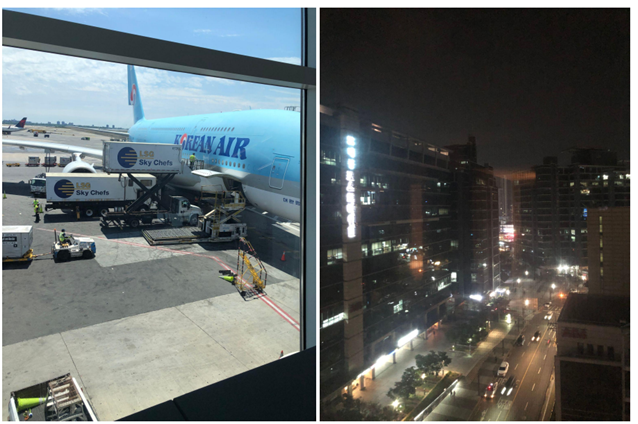Tristan Green, recipient of the 2022 Secondment Program award, has completed his program and wrote the following to share with the FLUXNET community:
__________________
FLUXNet Secondment Program Seoul NCAM Blog Post
By Tristan Green
On July 4th, 2022 many Americans were out celebrating National Independence Day, however, I
was flying to Seoul, South Korea to start my 24-day journey working and learning under
professional scientists at the National Center of AgroMeteorology (NCAM).

(Left) Picture of the plane (Korean Air – Boeing Airbus A320) taken from New York, JFK Airport.
(Right) View from my hotel the night I arrived.
All of this is made possible by the FLUXNet organization opening a new program, the
Secondment Program, which sends early career scientists internationally to learn from renowned
professional scientists in a field that utilizes eddy covariance tower data. For my stay, I mainly
worked with Dr. Minseok Kang and Dr. Sungsik Cho, two long-term data scientists at NCAM.
We were interested in characterizing decreased carbon uptake due to different levels of severity
of forest fires in South Korea using eddy covariance tower data, remote sensing, and derived
models. Thus, my days upon arrival consisted of working in the office on this project and going
out to the eddy covariance tower sites to provide some assistance and learn about their history. In
my first week working at NCAM, we had a two-day stay out in Paju, South Korea where two
rice agriculture tower sites were located.
Me at a Paju rice agriculture tower site (July 6th).
My second week consisted of much the same, working on the designed project within the office
and going out to another large eddy covariance tower site in Mountain Taehyun. As I was
brought to each of these eddy covariance towers I learned about the reasoning and history of
installment. Additionally, how many of the scientists at NCAM utilize these towers for their own
research purposes. Throughout my time there I met with other people within the office and
learning about how they approach and conduct their own separate research. It was interesting
seeing how all of the scientists were using the eddy covariance tower data to analyze different
research topics. It was always wonderful having lunch together with the other scientists as it was
a great time to talk and learn with everyone further. Dr. Kang, Dr. Cho, and I met often to discuss
how the project was progressing and how we would like to move forward.

(Left) Me at one of the Mountain Taehyun forest tower sites. (Right) My office space within
NCAM.
For the third and final week of my secondment, Dr. Kang, Dr. Cho, and I stayed in Gangneung
Province for three days where we visited three other forest covariance tower sites and did a
personal investigation of the specific area where we were studying the recent forest fires and
their effects on carbon. One interesting thing we noticed when we were out inspecting the forest
fire site is the differences in burns within tree species. The deciduous forest tended to be less
severe in terms of burn compared to the conifer forest. We hope to further investigate this
relationship and add it to our original project scope.

(Top-Left) Dr. Cho and I on top of a forest eddy covariance tower site. (Top-Right) Me on top of
the canopy in another forest tower site. (Bottom-Left/Right) Recent forest fire aftermath area.
Three weeks went by fast as the night before I was to depart from Seoul, the NCAM office and I
went out to celebrate and enjoy our final time together. We rented a ‘yoat’ on the Hangang River
in Seoul where we were greeted with a fantastic light/water show and relaxed with the pleasant
weather. Afterward, we stayed in Hangang Park and listened to music, ate traditional ramen and
pork, and said our final goodbyes.

(Left) The NCAM office group on our ‘yoat’ on the Hangang River with the light/water show in
the background. (Right) The NCAM office group saying their final goodbyes in Hangang Park.
For my three and a half weeks, it was amazing and beyond beneficial for both my scientific
career and life experience. I would like to thank the Secondment committee for allowing me to
partake in the first Secondment Program, Dr. Kang for allowing me to be a part of the project and
providing me guidance throughout, and the NCAM staff for being very supportive and patient
with me! I will continue these relationships and harness the many things I have learned over my
time there and continue to develop my skills as a scientist.

